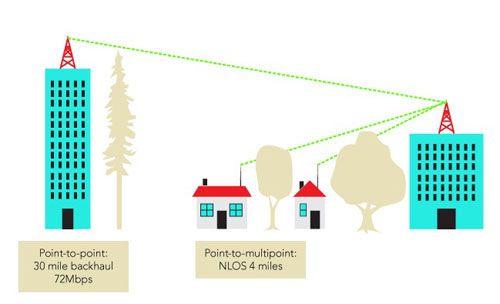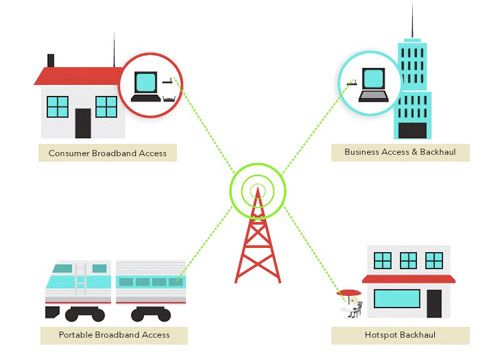Today, it may seem like Internet access is ubiquitous, but a new wireless broadband system called WiMAX (Worldwide Interoperability for Microwave Access) promises to revolutionize the utility and accessibility of the Internet. WiMAX technology has a longer range, higher spectral efficiency, and ability to connect multiple users at the same time. It also has a built-in adaptive algorithm that can shift between higher performance and longer effective range. The range of services it can offer include voice, video, and data, as well as mobility. Because it requires a system of towers and receivers instead of a physical fiber-optic cable network, using WiMAX to provide Internet access to remote or inaccessible locations can be a cost effective alternative. With further development and adoption, WiMAX will offer consumers a complete wireless Internet package.
What is WiMAX?
Imagine having the ability to connect to the Internet while sitting on a train or car travelling at more than 65 miles per hour. On your next road trip, you can check your email, watch your favorite TV shows online, search for good restaurants – the possibilities are endless. With WiMAX technology, this is possible. WiMAX, also known as Worldwide Interoperability for Microwave Access, is a wireless telecommunications system that enables users to take advantage of high-speed wireless data transfer, like Wi-Fi. WiMAX has a wide range of coverage and is renowned for its ability to provide mobility to its video, voice, and data services. With wider implementation and further development, WiMAX may well become the next generation of wireless technology.
How It Works
The WiMAX network consists of two parts: a WiMAX tower and a WiMAX receiver. The WiMAX tower is directly connected to the Internet via physical wire connections and provides wireless coverage by sending out a signal at a particular frequency that is picked up by a WiMAX receiver embedded in a device, like a laptop or cellular phone. Although WiMAX towers can broadcast to a wide area, obstacles can weaken or stop the signal from traveling past it. To compensate for this and further expand their coverage, WiMAX towers use the process of backhauling. In WiMAX backhauling, a tower sends wireless signal to a second tower in its line of sight, enabling the second tower to operate as a base station without having to physically connect to the Internet.
The WiMAX network has a much longer range than other wireless Internet technologies, with a point-to-point range of 30 miles. Even at these distances, it can maintain a performance of 72 Mbps, which is multiple times faster than a regular residential Internet speed. WiMAX also has a non-line-of-sight (NLOS) range of up to 4 miles when there is an obstacle between the provider and the receiver, as shown in Fig. 1. It is able to maintain this kind of coverage because it uses advanced modulation algorithms that can overcome interfering objects [1]. WiMAX also operates on a licensed spectrum, whose use is protected by government authorities. This licensed spectrum eliminates the possibility of interference from other service providers [2].
Another thing that sets WiMAX technology apart from other systems is that it uses a “dynamic adaptive modulation¨ that allows a particular base station to be able to exchange performance for range if needed [3]. If the base station needs to link to a distant subscriber, it would reduce its performance and consequently increase its effective range. With this dynamic property, WiMAX is a truly smart wireless technology, automatically adjusting its operations to maximize its efficiency.
WiMAX is Standard-Based
Some wireless broadband technology, such as Wi-Fi, has been standardized by the Institute of Electrical and Electronics Engineers (IEEE) to promote greater interoperability. In April 2002, the IEEE standardized the WiMAX technology as IEEE 802.16 [1]. Because WiMAX is standardized, each developer has to meet the specifications so that the performance is consistent across devices. The specifications may also include the types of equipment used. Without these standards, equipment manufacturers would need to provide all the hardware and software by themselves, which may include chip sets, subscriber station gear, and WiMAX base stations. “With the 802.16 standard in place, suppliers can amortize their research and development costs over a much higher product volume¨ [3]. Having a standard not only sets a minimum requirement for builders to meet but also ensures that technology from various suppliers can be compatible.
WiMAX vs. Wi-Fi
In the article thus far, it may not be clear how WiMAX is different from Wi-Fi. Although it is true that they have the same first two letters, they are certainly not the same technology. WiMAX is often nicknamed as “Wi-Fi on steroids¨, because it amplifies the abilities of Wi-Fi considerably [4].
If WiMAX provides services analogous to a cell phone, Wi-Fi is analogous to a cordless phone. Wi-Fi is a short-range system, typically covering just a few hundred meters, unlike the 30-mile maximum coverage radius of one WiMAX tower. Wi-Fi also cannot overcome interfering objects the same way that WiMAX can and it does not operate on a licensed spectrum.
WiMAX also has a significant advantage over Wi-Fi in its high spectral efficiency. Spectral efficiency is defined as the rate of information that can be transmitted over a given set of frequencies, or bandwidth. In other words, the higher the spectral efficiency, the faster the Internet connectivity. Because WiMAX’s level of spectral efficiency is high, it can distribute nearly any bandwidth to almost any number of subscribers. Wi-Fi is normally only used to grant access to a personal network, but WiMAX covers a large area and can therefore be shared by multiple clients.
Even though almost all mobile devices such as laptops and cellular phones are currently Wi-Fi embedded, this does not necessarily mean that Wi-Fi is the better technology. A large part of the reason why Wi-Fi is currently more popular is that it has been out for a longer period of time, whereas WiMAX is still in development.
WiMAX Applications
The WiMAX technology has a broad range of applications (see Fig. 2). First, it provides a wireless alternative to cable and DSL for broadband access for the areas in the United States and throughout the world that still do not have access to broadband connectivity. Using cable or DSL to provide broadband connections to these areas can be very time-consuming and expensive. With WiMAX, broadband service could be installed in just a few days with a significantly lower cost. Because 80% of cell base stations today are connected using expensive fiber optic cables, service providers may consider using WiMAX as a more cost-effective alternative [3]. Service providers can just use WiMAX to “beam¨ the data flow to the area or building, rather than digging trenches to run expensive fiber optics or other high-bandwidth cable services.
Since WiMAX base stations have a wide of coverage and can be installed quickly, WiMAX is also often used to connect Wi-Fi hotspots to the Internet for large temporary events such as trade shows. Because a WiMAX base station is small, cheap, and covers a large area, WiMAX can be used as a “broadband on demand¨ [5].
WiMAX also has the ability to provide wireless Internet connectivity on the move, providing an opportunity for true mobile connectivity of devices without cell network access. Mobile connectivity can lead to countless other applications, such as being able to use the Internet or watch television in a moving vehicle. As users become more and more dependent on Internet availability, having a wireless Internet network that rivals cellular phone coverage would be very advantageous.
A Potential Threat to Other Technologies
Because WiMAX provides what many call “the quadruple play” – data, voice, video, and mobility – WiMAX has the potential to replace many of the mainstream communications technologies. In addition, the wide range of coverage allows one WiMAX tower to service a larger area, meaning that fewer towers would need to be built in the first place. For example, say that a service provider wants to bring broadband service to a college campus. Instead of installing numerous base stations of other wireless technologies, such as Wi-Fi, the service provider can simply use one WiMAX base station to cover the entire campus. Therefore, installing WiMAX can be more cost effective for service providers.
The industries under jeopardy may include telephone and cell phone companies, cable and satellite television companies, and the fiber optic backhaul industry. WiMAX could potentially replace telephone and cell phone companies due to its convenience and lower cost in comparison to a cellular network. Since it is now possible to convert cable programming and deliver it over a broadband Internet connection, WiMAX can also replace cable television. The backhaul industries that use fiber optics are also in jeopardy. The backhauling networks used today were built mostly in the 1990s during the telecommunications boom, with fiber optics that cost billions of dollars. With the cheaper cost, faster speed, and wider range that a WiMAX network provides, the backhaul industry could easily be replaced [6]. Finally, the ability to bring mobility to its services could also make WiMAX more preferable. WiMAX technology will threaten the market share of telephone and cable industries as it becomes more widespread because it performs enhanced services for a lower cost.
The Future of Wireless Technology
WiMAX technology seems to have everything in one package. It can provide access to the Internet, television streaming, and wireless phone connection, all while incorporating mobility. While WiMAX is still a new technology, as it becomes more commonly used, the technology will become more widely available and the price will decrease. With all of the current development in the field, WiMAX technology may have the potential to revolutionize the world of wireless broadband within the next few years.





